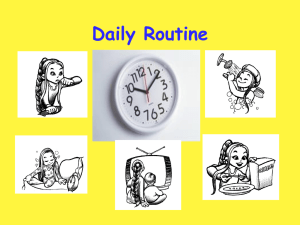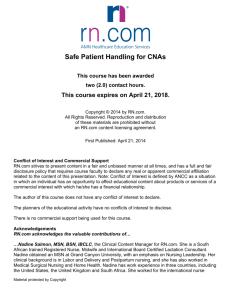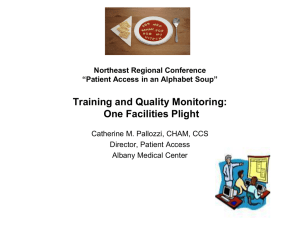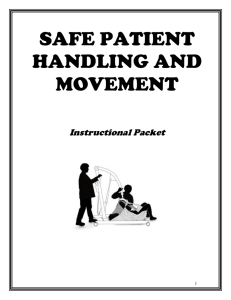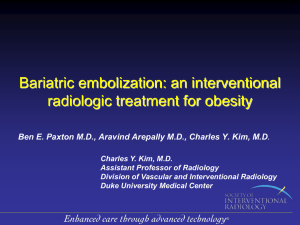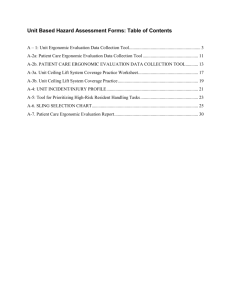SAFE PATIENT HANDLING - Washington State Hospital Association
advertisement
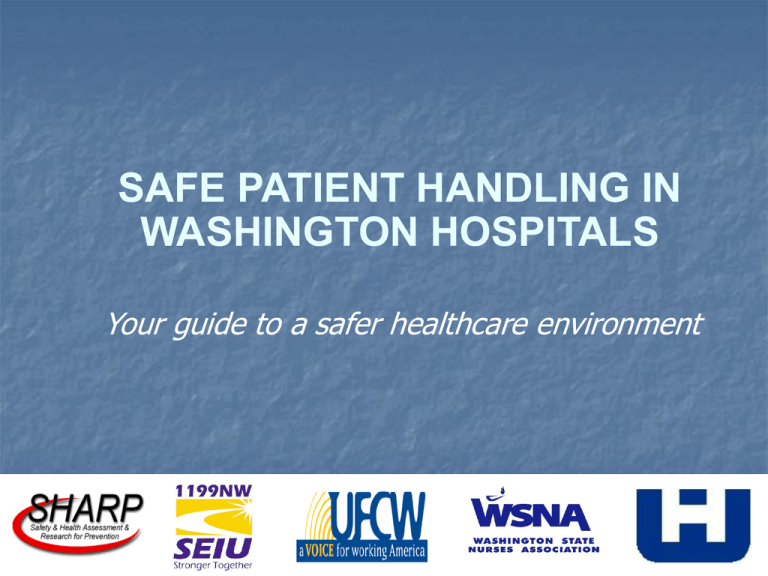
SAFE PATIENT HANDLING IN WASHINGTON HOSPITALS Your guide to a safer healthcare environment On the phone… Chris Barton SEIU 1199NW Dan Donahue Providence St. Peter Hospital Lynn LaSalle MultiCare Health System Barbara Silverstein Department of Labor & Industries Brenda Suiter Washington State Hospital Association Credo “Patients should not be harmed by the care that is intended to help them, nor should harm come to those who work in health care” Crossing the Quality Chasm, 2001 Agenda Safe Patient Handling Law Background Safe Patient Handling Website Law Timelines Equipment requirements and funding Questions Safe Patient Handling Legislation Governor Gregoire signed Engrossed Substitute House bill 1672 on March 22, 2006 Bill became law on June 21, 2006 Legislation makes safe patient handling part of how hospitals provide care by adding this requirement to DOH hospital licensing requirements Background The law was supported by: Service Employees International Union Local 1199NW United Food & Commercial Workers’ Union Washington State Hospital Association Washington State Nurses Association Why was the law enacted? To improve the safety of healthcare employees and patients Provide funding to hospitals implementing safe patient handling programs To improve nurse retention To reduce costs to hospitals We Know… Nurses lift an estimated 2 tons per shift Do the math: Number of patients/day Number of lifts/patient Average weight/patient 4 X 6 X 170 = 4,080lbs/day We know… 38% of nurses suffer work-related back injuries requiring time away from work 12% of nurses consider leaving nursing due to low back pain at average age 39 Nurse aides have also experienced significant injury “Zero-Lift” Program Lifting programs have been proven to be effective. WHS’s Workers’ Compensation “Zero Lift Program” has experienced remarkable success: Patient Handling injuries had decreased by 43% Time loss frequency rates had decreased by 50% Safe Patient Handling Steering Committee Collaboration developed to provide tools and models that will help hospitals implement safe patient handling programs. Healthcare Unions Department of Labor & Industries Physical and Occupational Therapists Employee Health Managers Urban and Rural Hospital Administrators Washington State Hospital Association Washington Hospital Services’ Workers’ Compensation Program Law Timelines February 1, 2007 – establish safe patient handling committee December 1, 2007 – implement safe patient handling program January 30, 2010 – acquire lifting equipment Enforced by the Department of Health Poll Question Flow Chart February 1, 2007 Establish a safe patient handling committee with at least half of the committee being direct care staff Establishing a Committee Recruit Participants (50% direct care staff) Elect committee chair and co-chair Develop meeting schedule and protocols The primary responsibility of the committee is to establish, implement and monitor the Safe Patient Handling Program. Labor Management The Steering Committee recommends union involvement in committee development and decision making Poll Question December 1, 2007 Establish a safe patient handling program Safe Patient Handling Program 1. 2. 3. 4. 5. Safe patient handling program shall include and hospitals must: Implement a safe patient handling policy Conduct a safe patient handling hazard assessment Develop a process to identify the appropriate use of the safe patient handling policy based on patient needs and availability of equipment Conduct an annual performance evaluation Consider the feasibility of incorporating equipment when constructing or remodeling a hospital Establishing a Safe Patient Handling Program 1. Implement a safe patient handling policy for all shifts and units of the hospital It is recommended your safe patient handling committee draft a policy together 2. Conduct patient handling hazard assessment. Include variables such as patient handling tasks, types of nursing units, patient populations, and the physical environment Establishing a Safe Patient Handling Program 3. Facilitate the development of standards for assessing each patient and their activities A. Get input for department staff B. Include how to document and share information across shifts and departments C. Consider using algorithms Establishing a Safe Patient Handling Program 4. Conduct an annual performance evaluation of the program to determine its effectiveness-report results to your safe patient handling committee 5. When developing architectural plans, consider the feasibility of incorporating patient handling equipment into the design What Makes a Successful Program? Analyze what works already in your hospital: Existing practices Attitudes about change Administration’s support Organizational culture Barriers to change Current patient flow Know Current Practices Department practices and techniques already used for handling their patient population Who is influential in each department the leaders of co-workers Educate Your Hospital Committee members to their role on the team, empower them to do their work Management - for staffing, so team members can attend meetings and do their work Keep the committee informed of their accomplishments so they feel successful Campaign – Build Momentum Use every modality possible to share what is being planned and implemented: Recruit an Administration sponsor who will speak directly to the care givers Design in accountability of managers, supervisors, charge nurses, house supervisors and direct care givers; to know when the team meetings occur, who the members are, department’s need for equipment, what systems and techniques will change, processes for acquiring what they need, etc. Inform Your Patients, Families, and Visitors Advertise in brochures, newsletters, hospital bulletin boards Create expectations Make the work of the committee public, positive and rewarding Please visit website to view a sample marketing materials Individual Patient Assessment Risk & Needs Assessment Measures to eliminate or reduce patient handling risks must be identified Conduct an analysis of injuries Identify and prioritize patient handling risks Assess patient mobility needs Conduct an inventory of patient handling equipment Identify environmental and system barriers Learn From Your Mistakes Conduct annual performance evaluations of the: System’s policy Committee’s work Program effect on injuries & falls Equipment Use Annual Performance Evaluation Change Can Be Hard Have activities with rewards for individual care givers and departments: Informal brown-bag lunches Departments can compete against each other Rodeos A Successful Program Adheres to the requirements of the law Meets all deadlines Uses the available tools Involves your safe patient handling team in decision making Shares experiences, ask questions Washington Regulatory Requirements1 When developing architectural plans for constructing or remodeling a hospital or unit, the hospital must consider the feasibility of incorporating patient handling equipment or design needed to incorporate equipment later. 1RCW 70.41.390 Before The Blue Prints Get all levels of staff involved Think about all possible scenarios Place real users in a mock up of the design concept and simulate simulation Full scale simulation with props or3-D computer simulations Working Space Transfer to Bed (Add 12” all around the bed for bariatric patient) Transfer bed /wheel chair or bed to stretcher: 1500 mm 5’ Transfer with floor lift or bed/geriatric chair 1800 mm 6’ (ceiling lift saves 12”) Space for care giver and rest chair 100 mm 39” Door room width 1220 mm (48”) for bariatric patient *Adapted from Jocelyn Villeneuve, Design for Safe Patient Handling Single Bed/Bath Room Layout Total Space ~180 sq ft Side nearest the door 6’ for a transfer involving floor device add 12” for bariatric Window side 47” Foot of Bed 47” Bed faces the door privacy maintained with curtain, better observation and transfer (working) space Door width 1220 mm (48”) for bariatric patient Bathroom Space Make sure equipment, staff and patient can fit in space. • 36” door • 24” minimum clearance on each side of toilet • Retractable bars attached to wall for client transfers assisted by 1-2 care givers • Wheel Chair rotation 5’ diameter • Toilet weight tolerance needs to be 600+ lbs January 1, 2008 A hospital shall develop procedures for hospital employees to refuse to perform or be involved in patient handling or movement that the hospital employee believes in good faith will expose a patient or a hospital employee to an unacceptable risk of injury. A hospital employee who in good faith follows the procedure developed by the hospital in accordance with this subsection shall not be the subject of disciplinary action by the hospital for the refusal to perform or be involved in the patient handling or movement. Employee Rights Hospitals MUST develop procedures for employees to refuse to perform or be involved in patient handling or movement task that the employee believes “in good faith” will expose a patient or employee to an unacceptable risk of injury Please visit website to view a model policy http://www.washingtonsafepatienthandling.org/image s/Refusal_final.pdf January 30, 2010 Each hospital must complete, at a minimum, acquisition of their choice of: One readily available lift per acute care unit on the same floor unless the safe patient handling committee determines a lift is unnecessary in the unit; One lift for every ten acute care available inpatient beds; or Equipment for use by lift teams Hospitals must train staff on policies, equipment, and devices at least annually January 30, 2010 Acquire equipment using your hazard assessment, injury data and with the input of the hospital’s safe patient handling committee Acquire Equipment Step 1: Establish a safe patient handling committee (50% direct care staff) Step 2: Train the safe patient handling committee Step 3: Write your Safe Patient Handling Policy Step 4: Assess the risks and needs for each unit in your hospital Step 5: Plan for the purchase of equipment Our “Challenge” Is: Getting the Equipment & Changing Practice… Getting from manual handling… To safe patient handling… Where is High Injury Risk Exposure? Inpatient Rooms* (+ OR, PACU, Rehab) Repositioning Move up, roll, clean Transferring Bathroom/Commode Walking Bed to Gurney Bed to Chair *Biomechanical Evidence… William Marras, PhD, CPE Example of continuous track from patient room to bathroom Where to put track… Committee Decision – Need/Data Driven Remodel Driven CCU-Tele-Neuro-Med/Renal-Rehab Or combo data/remodel, needs to be cleared w/committee “Track” As Many Rooms As Possible* Fixed Lifts – view rooms, plus as follows… Isolation Rooms CCU Known heavy low mobile patient care areas Portables (475 lb capacity) 1 per 5 rooms Use until you have budget for fixed lifts *Tampa General Model Patient Transfer Devices Floor lifts/Bariatric Room Set-up Slider Transfer Sheets Repositioning, floor to bed, bed to chair Beds Lateral and horizontal transfer Ceiling Lifts From floor, chair, bed, also sit to stand & walking Chair posit., flexi-foot, Trendelenburg Transport devices Zoom stretcher, bariatric stretcher, “Ergo-tug” This is a cut out of our transfer device locator Ceiling Lifts Portable lift on gantry (xy) configuration Pam working with training dummy and ceiling lift. Seated universal sling Repositioning is easy Full body repositioning sling December 30, 2010 A hospital may take a credit for the cost of purchasing mechanical lifting devices and other equipment that are primarily used to minimize patient handling by health care providers, consistent with a safe patient handling program developed and implemented by the hospital B&O Tax Credit All hospitals qualify for the B&O Tax Credit Hospitals can receive up to $1000 per acute care available inpatient bed The number of acute care available inpatient beds in each hospital is based on the year-end financial reports submitted to the Department of Health Form can be downloaded at: http://www.washingtonsafepatienthandling.org/images/B_O_tax_ form.pdf Poll Question The Patient Handling Bible In Summary Use hazard assessment, injury data and committee to make equipment acquisitions Equipment: key points Engage your facilities staff & give ergonomic input for construction remodel design Think BIG and spend lots! Thank you Service Employees International Union Local 1199NW Washington State Nurses Association Regional Hospital Regional Hospital for Respiratory and Complex Care Valley Medical Center Multicare St. Mary Medical Center Valley General Hospital United Food & Commercial Workers Union Local 21 Harrison Medical Center Kittitas Valley Hospital United Food & Commercial Workers Union Local 141 Providence St. Peter Hospital Empire Health Services Department of Labor & Industries Washington State Hospital Association Swedish Medical Center WHS Workers’ Compensation Program Thank you Chris Barton SEIU 1199NW Dan Donahue Providence St. Peter Hospital Lynn LaSalle MultiCare Health System Barbara Silverstein Department of Labor & Industries Brenda Suiter Washington State Hospital Association Questions Thank you for participating! Please fill out the evaluation.


